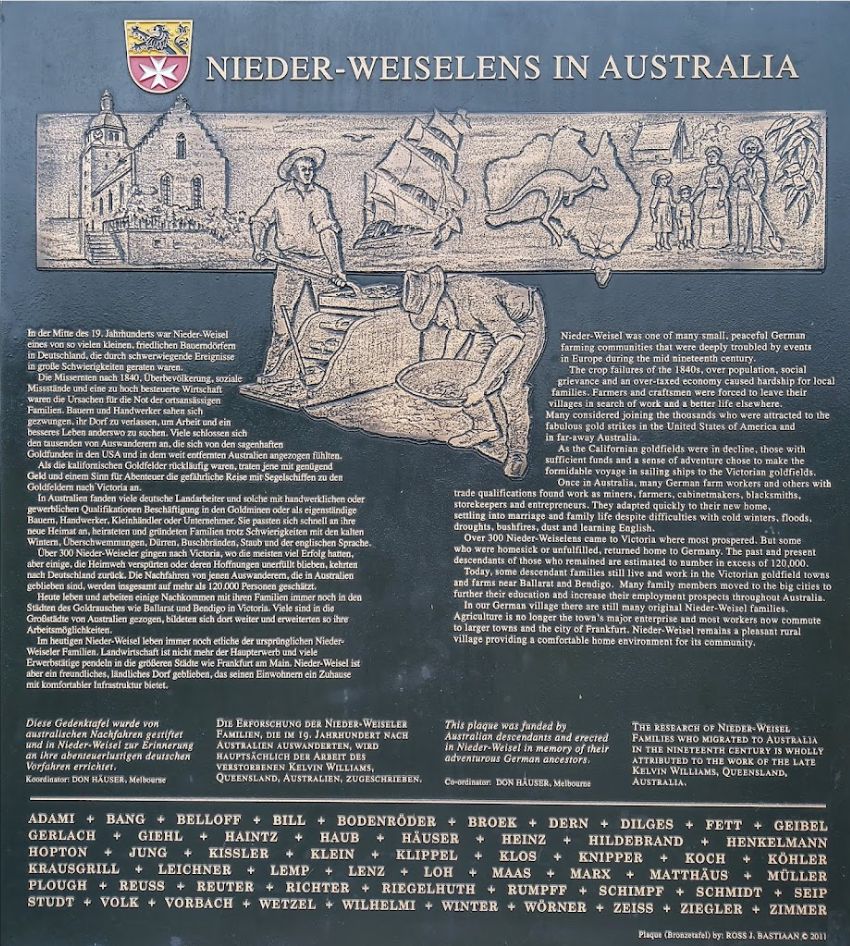Some years ago, Don Hauser, a present-day descendant of carpenter Johann Hauser who was in the first group of immigrants from Nieder-Weisel to reach Victoria, felt that the courage of all those immigrants, and the hardships that they endured, should be recognised in some way. He, with the help of his wife Jill, managed firstly to have the authorities in Nieder-Weisel agree to a monument being erected there, and secondly to locate enough people to contribute to the cost of making the project possible. In addition to generous financial help from Australian descendants, a number of Nieder-Weisel residents gave warm support, particularly Isabell Hauser-Hartl and Kristian Frank, both of whom had ancestors who migrated from Nieder-Weisel to Australia.
The design and production of the memorial was the next task. Don’s design concept was completed with guidance from Ross Bastiaan, a Melbourne periodontist, who has produced and installed 160 Australian military history plaques in more than 20 countries. After much discussion over several months, Don adapted Ross’s format with a design that suited the requirements perfectly, and he commissioned a Melbourne brass foundry, recommended by Ross, to create the monument. The final product plus granite supporting pillars was air-freighted to Germany in mid-2010, in time for the memorial unveiling on 3 October 2010, which co-incidentally was a few days prior to the date set for the re-unification of Germany. Herr Norbert Kartmann, local Nieder-Weisel politician and President of the Hessian Parliament, collected the memorial plaque at Frankfurt airport, arranged clearance from customs and, with the help of his driver, brought our very heavy bronze plaque to its new home-town.
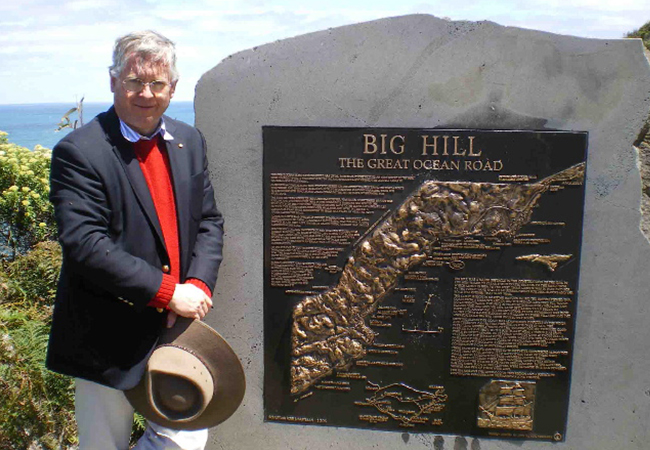
Don and Jill had previously taken the plan of the memorial to Nieder-Weisel so that a suitable site for it could be chosen. Pictured at the right (L-R) are Horst Hauser (Isabell’s father), Don, unknown, Isabell, Norbert Kartmann, Dorley Hauser (Isabell’s late mother), unknown, and local historian Klaus Hilderbrand.
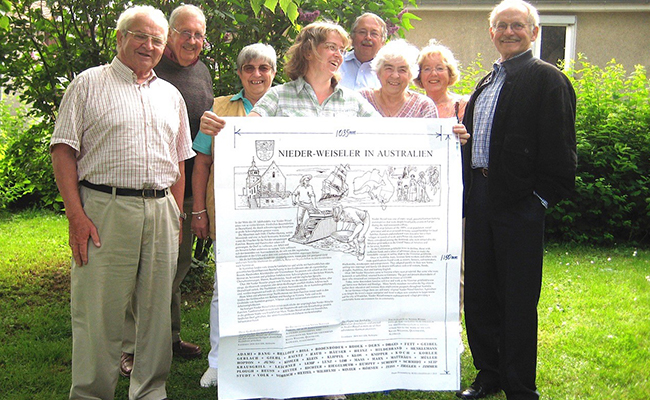
Twenty-five Australians made the trip over to Nieder-Weisel for the unveiling, where they joined 150 local residents for a weekend of celebrations, starting on Friday 1 October with a welcome dinner and ‘thank you’ to the many Australian supporters and N-W friends who helped with the planning and financial support for the event. This was held in a modern function room in the Johanniter Hotel, where most of the Australians were staying. On Saturday morning, light rain didn’t deter anyone from Jill Hauser’s history walk around Nieder-Weisel, with a kaffe und kuchen break generously provided by the church ladies.
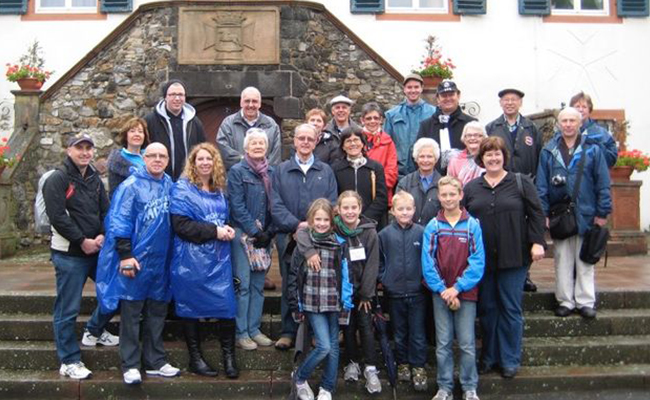
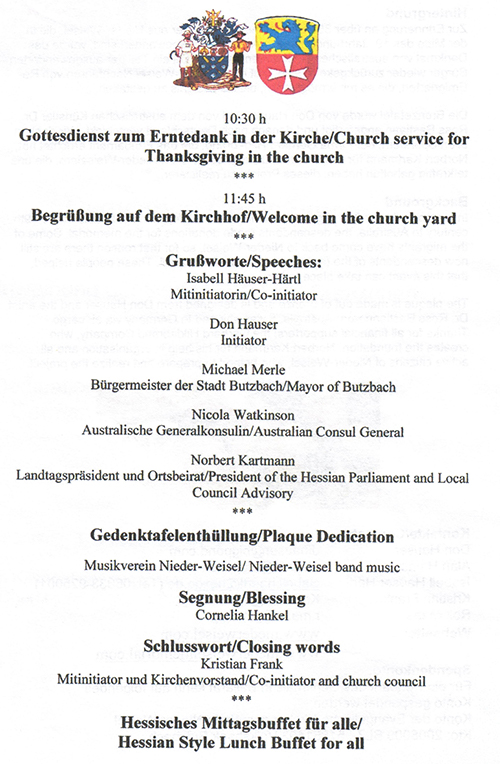
Late afternoon, with the help of Isabell and her children Geog and Klara, the visitors were shown how to bowl in the Kegel bahn nine-pin bowling alley located in the basement of the local pub, after which the inn-keepers Gerd and Renate Haub provided a traditional meal of wiener-schnitzel & salad, followed by Apfelstrudel.
The program for Sunday 3 October is set out on the left, starting with the special church service to celebrate Harvest and the 20th anniversary of the re-unification of Germany.
Following the service, about 150 people gathered to witness the dedication and blessing of the memorial which now stood proudly and permanently on two vertical columns in the adjacent garden. Invited guests included Herr Michael Merle (Burgermeister of Butzbach), Herr Norbert Kartmann (President of the Hessen Parliament), Mrs Nicola Wilkinson (Australian Consul General) and Pastor Cornelia Hankel.
Isabell Hauser-Hartl, assisted by her daughter Klara, told of the search for their Australian connections and their visit to Australia about 8 years ago.
Don Hauser thanked Herr Kartmann for his help and advice, subscribers and Nieder-Weisel friends for their support and friendship. Don then read the English text of the memorial and Kristian Frank read the German text.
Burgermeister Merle welcomed the Australians, local visitors and official guests. He later invited guests to sign the City of Butzbacb Golden Book.
Nicola Wilkinson spoke of how Australia’s character developed by the introduction of cultures from afar, and praised the instigators of the project for their achievement in this living history project. She said that an Australian Govt tourism facility now existed in nearby Frankfurt and exchanges of ideas will be possible.
Herr Norbert Kartmann concluded by reminding us that an official tourist pathway was now open in Frankfurt to travellers between Germany and Australia.
The banner at the top of this page shows the memorial in situ and the official party, L-R Kristian Frank, Don Hauser, Jill Hauserr, Isabell Hauser-Hartl, Nicola Watkinson, Michael Merle, Pastor Cornelia Hankel and Norbert Kartmann.
The church bells pealed at midday as Kristian Frank, Isabell Hauser-Hartl and Don Hauser unveiled the memorial. The Nieder-Weisel band played in the sunshine, while a beautiful Hessian-style buffet lunch was provided by the church council members.
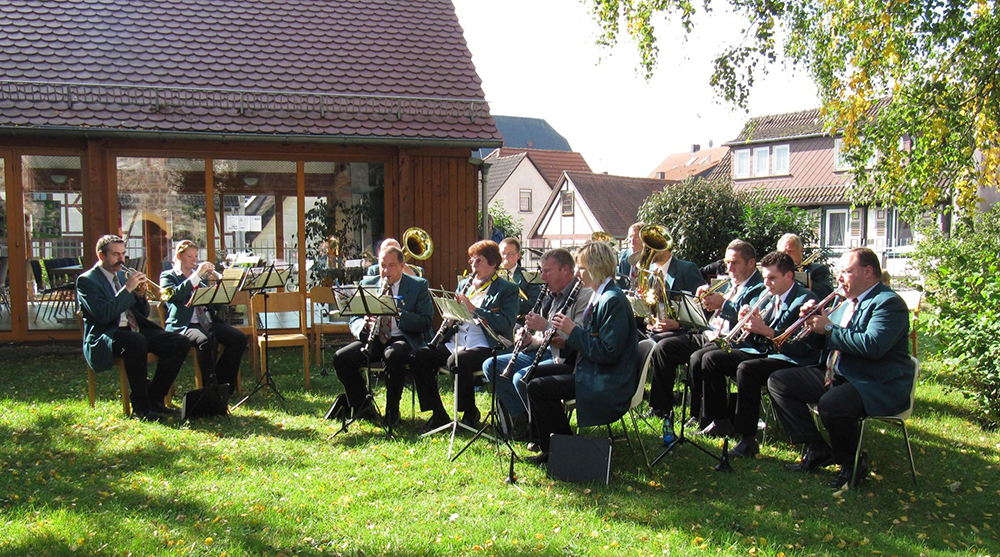
In the evening, the visitors were treated to a personally escorted walk around Butzbach by local historian Mrs Ulrike von Vormann, followed by a farewell dinner at a popular Butzbach bistro.
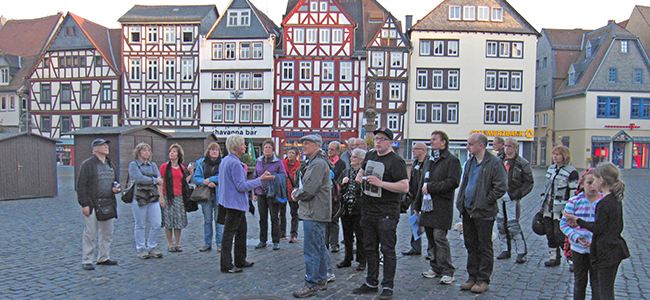
The crop failures of the 1840s, over population, religious divisions and an over-taxed economy caused hardship for local families. Farm workers were forced to leave their villages in search of work and a better life elsewhere. Many considered joining the thousands who were attracted to the fabulous gold strikes in the United States of America and in far-away Australia.
As the Californian goldfields were in decline, those with sufficient funds and a sense of adventure chose to make the formidable voyage in small sailing ships to the Victorian goldfields.
Once in Australia, many German farm workers and others with trade qualifications found work as miners, farmers, cabinetmakers, blacksmiths, storekeepers and entrepreneurs. They adapted quickly to their new home, settling into marriage and family life despite difficulties with cold winters, floods, droughts, dust and learning English.
Over 300 Nieder-Weiselans came to Victoria where most prospered, but some who were homesick or unfulfilled, returned home to Germany. The past and present descendants of those who remained are estimated to number in excess of 120,000. Today, some descendant families still live and work in the Victorian goldfield towns and farms near Ballarat and Bendigo. Many family members moved to the big cities to further their education and increase their employment prospects throughout Australia.
In our German village there are still many original Nieder-Weisel families. Agriculture is no longer the town’s major enterprise and most workers now commute to the larger towns and the city of Frankfurt. Nieder-Weisel remains a pleasant rural village providing a comfortable home environment for its community.

Donations to cover the cost of casting the bronze memorial plaque were over-subscribed, and it happened the surplus was sufficient to have a second cast poured for a fraction of the first. How better could this duplicate be used than but for a memorial to be erected at the beginning of the migration, but also at the end of this great adventure – the goldfields of the Ballarat area! Having successfully achieved the Nieder-Weisel project, then came the added task of obtaining permission to erect the second memorial in Ballarat. The authorities there were very enthusiastic and co-operative about the idea, suggesting a few sites, but for one reason or another none of them were entirely suitable. Don considered another location, Smythesdale, which had become home to many Nieder-Weisel migrants. Locals welcomed the idea.
Smythesdale was chosen because (a) about half of the immigrants first settled there, (b) the local historical society (the Woady Yaloak Historical Society is a very active one, it is housed in modern new offices, and it has a great collection of Nieder-Weisel material, including many letters to and from the immigrants), and (c) the area is much more secure than others that were suggested.
The unveiling of the second memorial was set down for Friday 19 January / Saturday 20 January 2013. The programs for both days are set out below. As cane be seen, Isabell Hauser-Hartl and Kristian Frank were both able to come to Australia for the event.
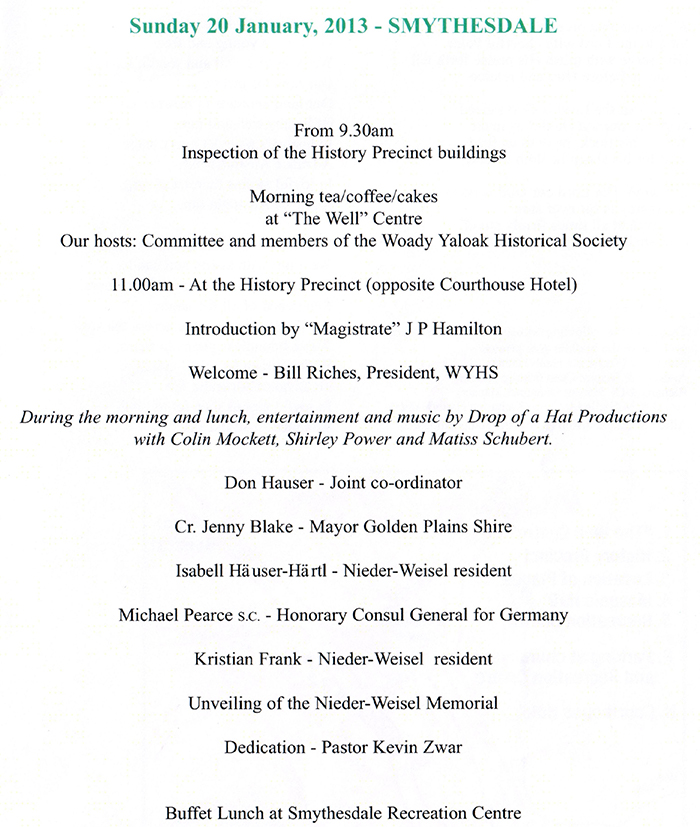
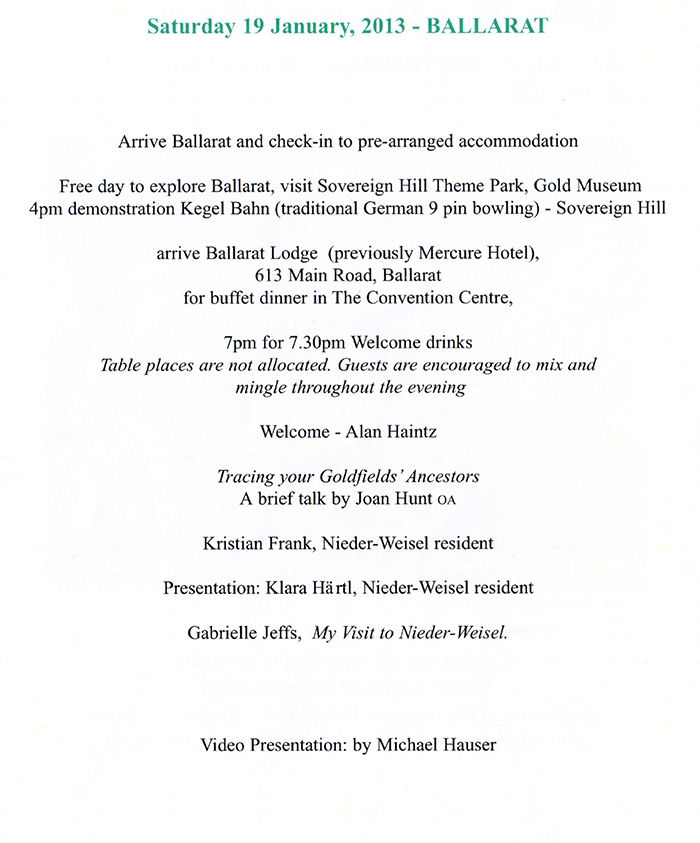
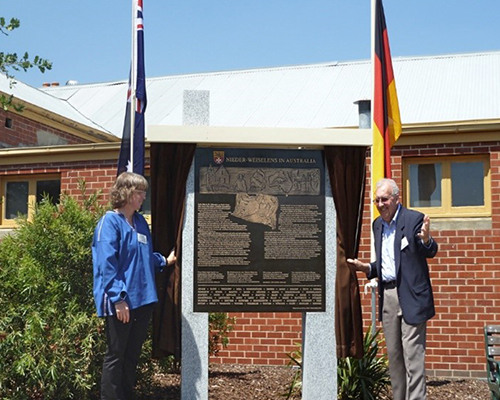
Isabell Hauser-Hartl and Don Hauser unveil the memorial with flagpoles and curtain structure by courtesy of the Woady Yalloak Historical Society.
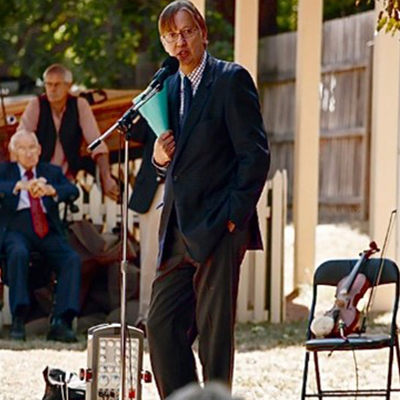
Michael Pearce SC (Honorary Consul General for Germany) giving his address.
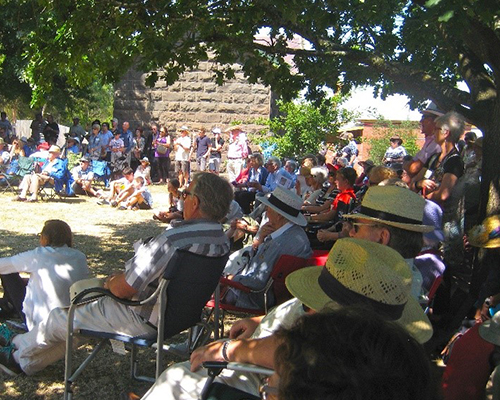
The large gathering of mostly Nieder-Weisel descendants finding shade in the January heat, and enjoying the entertainment and speeches.
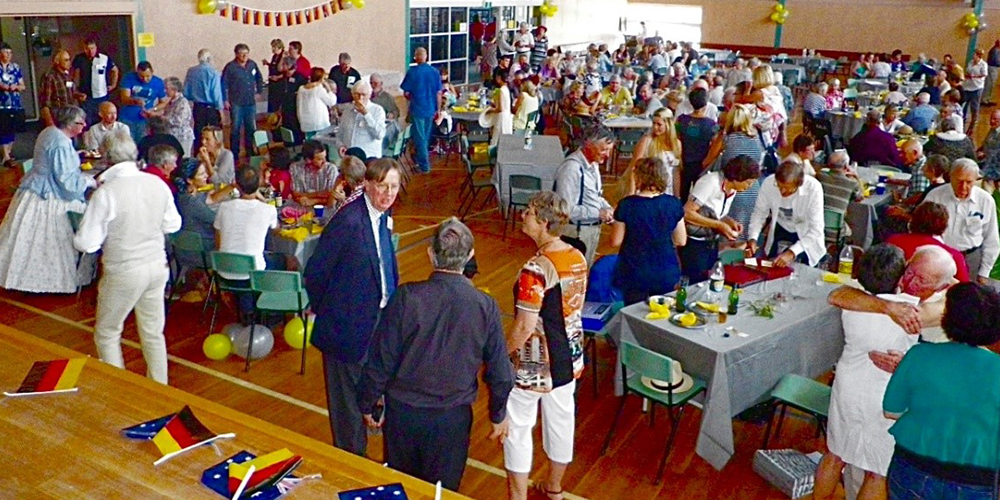
Some of the large audience of 250 enjoying the buffet lunch.
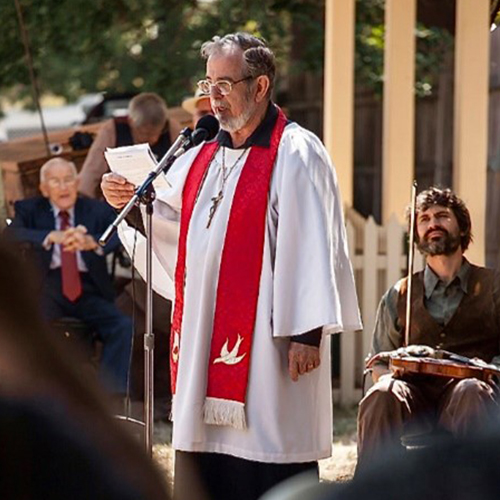
Lutheran Pastor Kevin Zwar blessed and dedicated the Smythesdale memorial.

